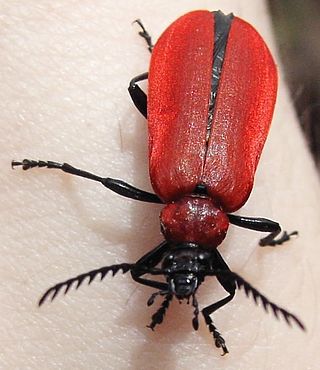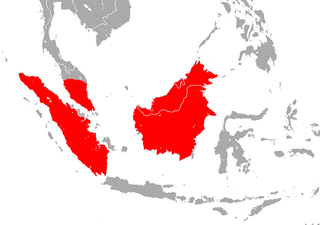
Genus is a taxonomic rank above species and below family as used in the biological classification of living and fossil organisms as well as viruses. In binomial nomenclature, the genus name forms the first part of the binomial species name for each species within the genus.

Senecio is a genus of flowering plants in the daisy family (Asteraceae) that includes ragworts and groundsels.

The naked-back knifefishes are a family (Gymnotidae) of knifefishes found only in fresh waters of Central America and South America. All have organs adapted to electroreception. The family has about 43 valid species in two genera. These fish are nocturnal and mostly occur in quiet waters from deep rivers to swamps. In strongly flowing waters, they may bury themselves.

Pauropoda is a class of small, pale, millipede-like arthropods in the subphylum Myriapoda. More than 900 species in twelve families are found worldwide, living in soil and leaf mold. Pauropods look like centipedes or millipedes and may be a sister group of the latter, but a close relationship with Symphyla has also been posited. The name Pauropoda derives from the Greek pauros and pous or podus, because most species in this class have only nine pairs of legs as adults, a smaller number than those found among adults in any other class of myriapods.

Desulfobacterales are an order of sulfate-reducing bacteria within the phylum Thermodesulfobacteria. The order contains three families; Desulfobacteraceae, Desulfobulbaceae, and Nitrospinaceae. The bacterium in this order are strict anaerobic respirators, using sulfate or nitrate as the terminal electron acceptor instead of oxygen. Desulfobacterales can degrade ethanol, molecular hydrogen, organic acids, and small hydrocarbons. The bacterium of this order have a wide ecological range and play important environmental roles in symbiotic relationships and nutrient cycling.

Fire-coloured beetles is the common name for members of the tenebrionoid family Pyrochroidae. The family is found worldwide, and is most diverse at temperate latitudes. Adults measure 2–20 millimetres (0.079–0.787 in); larvae reach 35 millimetres (1.4 in). Larvae of Pyrochroinae are found associated with the bark of dead trees. They are probably mostly fungivorous, although they may become cannibalistic if too crowded.

Zonitidae, common name the true glass snails, are a family of mostly rather small, air-breathing land snails, terrestrial pulmonate gastropod mollusks in the superfamily Zonitoidea.
The Guadalcanal rat is a species of rodent in the family Muridae. It was found only in the Solomon Islands. Since this species was collected between 1886 and 1888 it has not been seen again. It is possibly extinct.

The Borneo roundleaf bat or Bornean leaf-nosed bat is a species of bat in the family Hipposideridae. It is found in Borneo, Sumatra and Peninsular Malaysia. Hipposideros sabanus is a synonym of this species.

Apsilocephalidae is a family of flies in the superfamily Asiloidea. It was historically treated as a subfamily within Therevidae, but placed in a separate family in 1991, and subsequently recognized as more distantly related. The family contains three extant genera and at least five extinct genera described from the fossil record.

Chelisochidae is a family of earwigs whose members are commonly known as black earwigs. The family contains a total of approximately 96 species, spread across sixteen genera in three subfamilies.

Peripatopsidae is one of the two living velvet worm families. This family includes more than 140 described species distributed among 41 genera, but some authorities deem only 131 of these species to be valid. The French zoologist Eugène Louis Bouvier proposed this family in 1905 with Peripatopsis as the type genus.

Scolopocryptopidae is a family of blind centipedes in the order Scolopendromorpha. The number of leg-bearing segments is fixed at 23 for species in this family, which distinguishes the species in this family from all other centipede species. This family includes more than 90 species.

Geophilidae is a family of soil centipedes in the superfamily Geophiloidea and the order Geophilomorpha. In 2014, a phylogenetic analysis based on morphological and molecular data found this family to be polyphyletic. To avoid this polyphyly, authorities dismissed the families Aphilodontidae, Dignathodontidae, Linotaeniidae, and Macronicophilidae, which are now deemed to be junior synonyms for Geophilidae. Authorities also moved some genera from Geophilidae to form the family Zelanophildae in order to avoid the polyphyly of the family Geophilidae. The family Geophilidae now includes more than 650 species in more than 120 genera. This family has a cosmopolitan distribution, with species found almost worldwide.
Fuhrmannodesmidae is a family of millipedes belonging to the order Polydesmida. Although some authorities deem Fuhrmannodesmidae to be a junior synonym for Trichopolydesmidae, others still regard the taxonomic status of Fuhrmannodesmidae as valid. The family Fuhrmannodesmidae includes over 50 genera.
Arthrostylidium sarmentosum is a species of Arthrostylidium bamboo in the grass family. The species is native to Central America, the West Indies, northern South America, and southern Mexico.

Siphonotidae is a family of millipedes in the order Polyzoniida. This family includes more than 70 species distributed among 13 genera. These millipedes are found in South America, South Africa, Madagascar, Southeast Asia, and New Zealand. Millipedes in this family have a narrow telson and are quick and active.

Enteridium is a genus of slime molds belonging to the family Reticulariaceae.

Perimyotini is a tribe of bats in the family Vespertilionidae. It contains two species of bats found in North America, each in their own monotypic genus.

Lasiurini is a tribe of bats in the family Vespertilionidae. It contains three genera of bats found in the Americas. All three genera were previously considered one genus, Lasiurus, but have since been split from one another. However, the validity of this split is still debated.


















